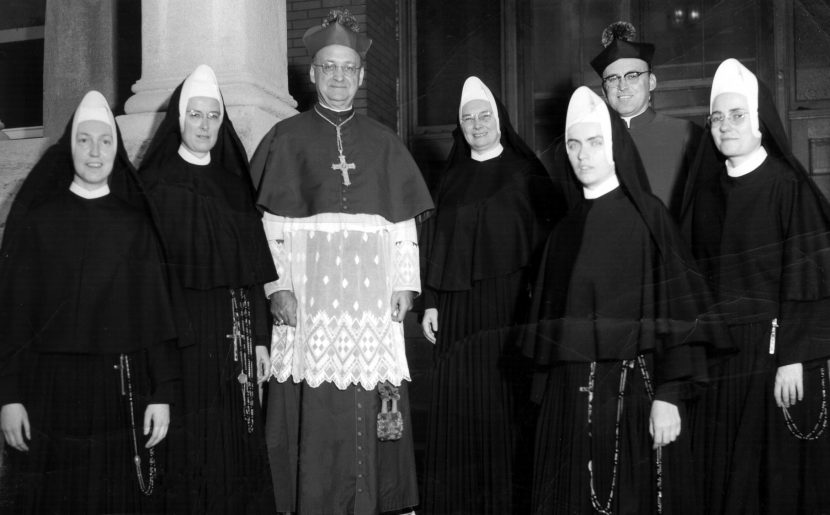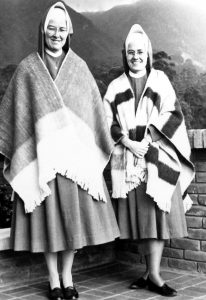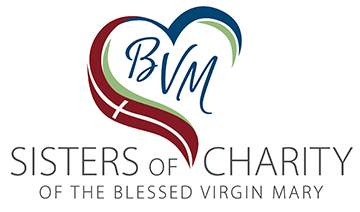BVM Ministry in Latin America: Beginnings

After the Commissioning Ceremony, BVMs assigned to Bogotá Eileen McGovern (l.), Liam Gallagher, Veronica Moore, and Mary Loftus gather with Dubuque Archbishop Leo Binz, Sister Helen Wright, and chaplain Msgr. Francis Dunn.
From the Fall 2004 issue of Salt
by Eileen McGovern, BVM
On July 7, 1961, Sister Helen Wright (then Mother Consolatrice) wrote a letter to all BVM houses announcing that a decision had been made to send two sisters to Bogotá, Colombia, later that summer and to assign two sisters to study at St. Louis University to prepare them for ministry in Latin America.
That was an historic moment in the BVM congregation. Earlier, sisters had studied in foreign countries, but this was the first time that BVMs were assigned to minister in a foreign country.
In her letter she made it clear that she envisioned this commitment to Latin America as continuing indefinitely. She stated, “I wish to make it clear that this is only the beginning of an important apostolic work and that there is a possibility that many of our sisters will be needed for this work.”
Urgings from Rome
Shortly after assuming the pontificate, Pope John XXIII had begun urging religious congregations to make a commitment to the church’s ministry in Latin America, and Helen Wright was responding to that plea.
Later that summer at the University of Notre Dame, Msgr. Agostino Casaroli, a representative of the Vatican Pontifical Commission for Latin America, addressed the 150 major superiors of religious congregations of women and men in the United States present at that convocation.
He asked that within the next 10 years each congregation send 10 percent of its membership as of that year to serve the church in Latin America.
In 1961, more than 200,000 religious served in the United States. So if that request were fulfilled, it would result in around 20,000 American religious devoting themselves to service in Latin America.
For the BVM congregation, this would mean sending about 200 sisters to Latin America within 10 years. In his address, Msgr. Casaroli described U.S. congregations as “rich in personnel.”
It is interesting to note that in Helen Wright’s letter to the congregation, she mentioned that more than 100 young women would be entering our novitiate program that summer.
The Mission Begins

The first four BVMs assigned to the program were Veronica (Ruth Marie) Moore, Eileen (James Leone) McGovern, the late Liam Gallagher and Mary (Malachy) Loftus.
Veronica and Eileen went to the Jesuit university in Bogotá with the intention that they would return to the states the following year to begin doctoral studies in education and in sociology. Liam and Mary were assigned to begin their studies at St. Louis University that fall.
Veronica returned to St. Louis after a year and was replaced by Adora Pelland, BVM. Both Liam and Mary Loftus came to Bogotá after finishing their studies at St. Louis University in sociology and education, respectively.
In 1963, St. Louis University obtained a contract with US-AID to update English language teaching at the Catholic university in Ecuador. BVM sisters were requested for that program, and Helen Wright responded by sending now-deceased Margaret (St. Jude) Houlihan, BVM to Quito to work with the English language program there. Two years later, BVM Thaddene McTeague (Patricia McTeague) joined Margaret in Quito.
At that time, an American Jesuit, John Halligan, was working with the shoeshine boys in Quito. On a visit to the states in 1963, he visited with Helen Wright and asked for sisters to assist him in his project.
In 1967, Miguel Conway, BVM went to Quito to work with John Halligan. Within the next few years, BVMs Anna Priester and Mary (Valerie) Waddell joined her.
What began as a place where the shoeshine boys could come for a meal and wholesome recreation has now grown to become a center where not only these young entrepreneurs but also their families are welcomed for three meals every day except Sunday, an opportunity for education, and daily liturgy.
Joan (Joan Michael) Newhart, BVM joined the faculty of the chemistry department at Universidad Javeriana in Bogotá in 1965 and remained there until 1968 when she and Eileen McGovern left their teaching positions at the university in Bogotá to help establish the chemistry and sociology departments at a Jesuit university in Salta, Argentina.
Unlike the Universidad Javeriana, which had been founded in 1622, the Catholic University of Salta was a new foundation in an area of Argentina where Catholic higher education had never been available. The BVM connection with that university lasted just one year.
Thus, 10 years after our initial commitment to Latin America, only 11 BVMs had been assigned to ministry in Latin America. The world and the church had both changed dramatically during that decade.
Short-term Opportunities Offered
It is very possible that our BVM commitment to Latin America might have remained minimal except for the enthusiasm of Adele Henneberry, BVM. Adele was elected to leadership in December 1967. During her years in leadership, she had had the opportunity to visit the sisters in our Latin American missions.
After completing two terms on the leadership team, she studied Spanish and concluded her sabbatical year by spending time in Guatemala.
When Adele returned to the United States after that experience, she felt that she had been enriched in a way that she had not dreamed possible. She concluded that other BVMs should be offered the same kind of opportunity.
The following summer at the BVM Senate of 1978, Adele introduced a proposal that the congregation fund a program designed to offer BVMs a Third World experience. The proposal passed, a committee was formed that fall, and the summer of 1979 eight BVMs spent six weeks at a missionary site in Mexico, Ecuador, or Guatemala.
In succeeding years, BVMs were hosted also in the Philippines, Africa, and India, but of the 67 BVMs who participated in that program in the first 10 years of its operation, two-thirds had their experience in a Latin American country.
A Continuing Choice
The short-term experience led many BVMs to a further commitment in working with Hispanics in Central and South America, and here in the United States. When sisters were free to choose their ministries, the Spirit continued to lead BVMs south of the border.
Numerous BVMs have served the Family of Families in Quito. Anna Priester and Mary Waddell moved from Ecuador to Guatemala, where they have ministered for 15 years.
Joellen McCarthy worked with the Maryknoll Sisters in Nicaragua for several years.
Former BVM Pat McTeague, together with Sonya Rendon, founded Nuevo Mundo School in Guayaquil, Ecuador. BVMs taught there, and Ann Credidio, BVM then was led to establish Damien House for person with Hansen’s disease.
Thus, although the program Sister Helen Wright envisioned did not come to fruition, through the years the spirit of collaboration with and love for the Hispanic people has grown and deepened.
About the author: Eileen McGovern, BVM, one of the South American pioneers, ministers as a Spanish therapist with Catholic Charities of the Archdiocese of Dubuque.
